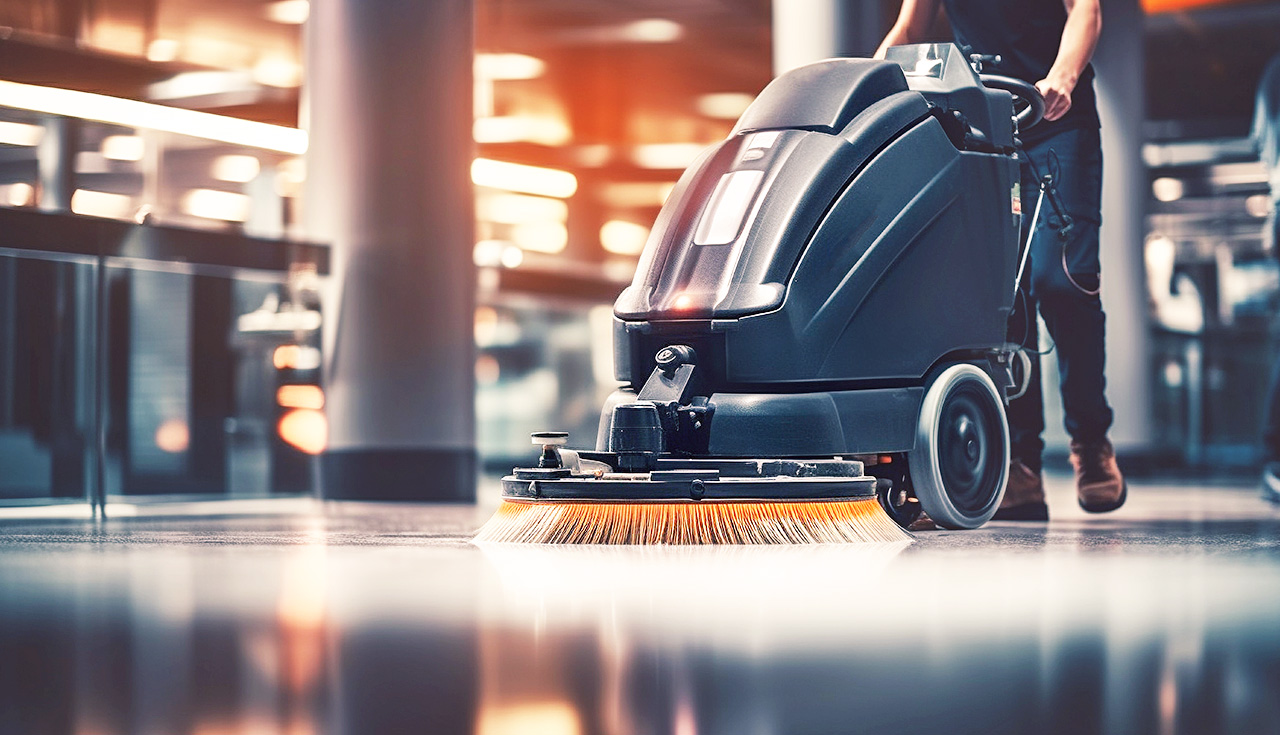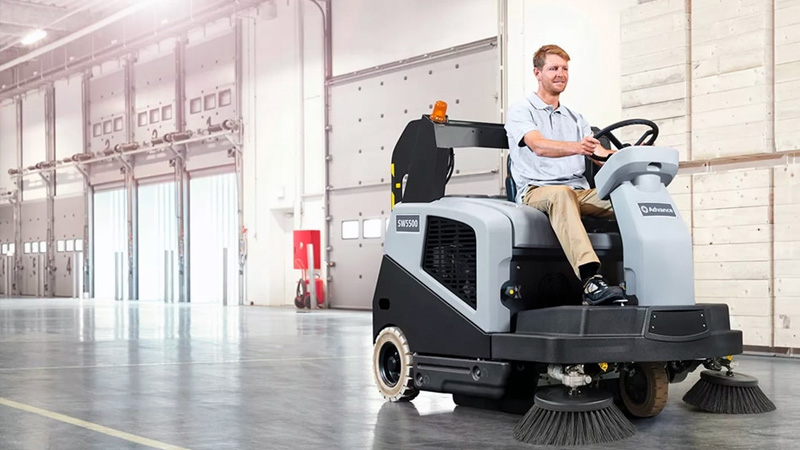Industrial Floor Cleaning Best Practices

Cleaning warehouse floors effectively is crucial for maintaining a safe and efficient work environment. Ongoing maintenance can lengthen the life of the warehouse flooring thus preventing unnecessary repairs and saving money for the company.

Warehouse flooring can be built from a variety of materials. The amount and weight of the loads, racks, products and forklifts in a warehouse operation can determine the type of flooring that will be the best quality for the long term. Rubberized flooring has a padded feel to it and can reduce slipping in liquid spills. It is durable but will show stains if not cleaned properly. Stained concrete is used for flooring in a space where looking good is important. It is liquid-resistant to staining but can cause falls if the liquid isn’t cleaned up immediately. It isn’t as resistant as other flooring materials. Epoxy resins on concrete will be highly resistant and is often used for warehouse flooring. Polyurethane cement flooring is known for its firmness and durability.
In order to create best practices, it is important to develop a strategy for maintenance and cleaning of the warehouse floor. Determine what the floor should look like. Will customers see it? If so, an attractive and clean warehouse facility can actually attract customers. Walking on a clean floor and seeing inventory that is clear of dust and debris would be a benefit when showing customers around the warehouse. Customers and workers alike will appreciate a clean warehouse floor. Workers will also appreciate handling materials that are dust free. Glossy floors can be attractive but care should be taken so that slipping in a puddle of liquid doesn’t occur. When warehouse floor activities are operating non-stop, it is still important to take the time to sweep and scrub the floors. Floor maintenance should support the operation’s efficiency and productivity goals. As a base of operation, the warehouse floor is the cornerstone for supporting a multitude of activities in the warehouse. And it makes sense that keeping up with customer demands requires a clean working environment.
Following are some best practices to ensure the warehouse floor is clean of debris, dust and spills to prevent accidents. Safety of the workers is a top priority.
- Daily Sweeping: Regularly sweep the floors using industrial brooms or sweepers to remove dirt, dust, and debris. This prevents buildup and reduces the risk of slips and falls. It is important to sweep prior to scrubbing so that dust and dirt particles do not prevent the scrubber from working at maximum capacity. Sweeping every day at the end of the day is a best practice. Sweeping up large debris that block aisles or prevent equipment from moving efficiently should be done as soon as it is noticed. There are a variety of types of sweepers. The direct throw sweeper is like a lobby pan and broom and can be used for removing dust, tiny particles of dirt and small trash items. Overthrow sweepers pick up debris and throws it over the broom and into a hopper. This kind of sweeper is good for larger particles and cleans a larger area without needing to empty the hopper so frequently.
- Use of Floor Scrubbers: Invest in or hire floor scrubbing machines designed for warehouse use. These machines efficiently clean large areas and can remove tough stains and grime. Be sure to sweep first to remove dry dust and dirt particles. Start with a clean floor without particles or stains that might wear down or damage the surface of the scrubber. Liquid or other stains from a previous scrubbing could also be transferred to the clean floor. So be sure the warehouse floor is swept first and spills are mopped up immediately and before scrubbing. Any particles that are scrubbed up before sweeping will eventually reduce the scrubber’s performance.
Choose the Right Floor Cleaning Equipment
Select equipment that performs with high productivity and efficiency instead of what may be the lowest cost. Determine how the equipment will be used by evaluating the size of the floor space to be cleaned and what obstacles such as racks or conveyor systems could prevent the flow of the sweeper or scrubber. Selecting equipment that is too small can add labor costs of taking too long to complete the floor cleaning. An increase in the return on investment by purchasing a machine that is large enough to handle the task effectively and efficiently by reducing the number of labor hours is ideal. A machine that is versatile in handling areas of both an extreme amount of debris and lesser amounts is a good choice. Make sure the machine is maneuverable in tight aisles, narrow doorways or small elevators. The manufactured types of equipment include walk-behind floor scrubbers and sweepers or ride-on floor scrubbers and sweepers. Sweepers will have different types of vacuum containers and can be interchangeable depending on the amount and size of the debris. There will be different kinds of solution and recovery tanks as well. The machine should be durable and easily operated. Check the down pressure and brush speeds for efficiency. For warehouse floors that are glossy, machines with burnishers are available with either a battery source or a power cord. Some equipment will sweep and scrub at the same time, saving labor costs. Selecting streamlined, cutting edge cleaning equipment that includes advanced technology will produce higher performance and productivity. And as with other robotic innovations in warehouse automation, the performance of the machine can be monitored and reported.
- Choose the Right Cleaning Products: Use cleaning solutions appropriate for a floor type, whether it is concrete, epoxy or rubber. And use the appropriate cleaner for the type of dirt you encounter, such as oil spills, general dirt or dust. Avoid products that leave residue or are too harsh for your flooring. The scrubber manufacturer’s label will advise what cleaning solution is best for the machine.
- Spot Cleaning: Immediately clean up spills and stains to prevent them from spreading or becoming harder to remove over time. Have absorbent materials like rags or spill kits readily available for quick response. Because of the normal wear and tear on a warehouse floor from high volume and fast paces it is hard to keep the trash and dirt picked up. To keep up productivity in a busy operation, clearing the warehouse floor may not be a top priority; however it is imperative to maintain a clear and safe environment for the workers.
- Regular Maintenance Schedule: Implement a routine maintenance schedule that includes deep cleaning sessions. This could involve more thorough scrubbing, buffing (if applicable), and resealing (if necessary). Don’t forget the corners of the warehouse floor. If appearance of the warehouse floor is important then stain removal and gloss restoration should follow the sweeping and scrubbing.
- Safety Considerations: Ensure cleaning procedures do not pose safety risks to workers or damage equipment. Use signage to alert employees to wet floors or cleaning activities.
- Equipment Maintenance: Regularly maintain cleaning equipment to ensure they operate effectively. This includes checking brushes, vacuum systems, and fluid levels on scrubbing machines.
- Ventilation: Maintain adequate ventilation during cleaning to disperse fumes from cleaning chemicals and to promote drying of the floors. Selecting a machine that avoids spreading chemical fumes is highly recommended.
- Training: Train employees on proper cleaning procedures and safety protocols. Make sure they understand the importance of maintaining clean floors and how their actions contribute to overall warehouse safety. Cost of labor for cleaning is one of the most expensive in any operation. Select equipment that is easy to learn and use.
- Documentation: Keep records of cleaning activities, including dates, products used, and any issues noted during inspections. This helps track maintenance needs and ensures compliance with cleanliness standards.
By following these best practices, you can effectively manage warehouse floor cleaning to create a safer and more productive work environment.
Darr Equipment Company’s floor cleaning specialists can assist you in selecting the appropriate equipment and products for cleaning warehouse floors. Darr Equipment strives to better the well-being of its customers above all else. This goal is continually displayed through its intuitive and attentive customer service, highly-trained maintenance team, and top-of-the-line equipment offerings. Darr is the proud authorized dealer for Nilfisk-Advance and Factory Cat industrial sweeper and scrubber equipment brands.
Advance, part of the Nilfisk Group, is a leading global provider of commercial and industrial floor cleaning equipment. The machines deliver unmatched quality and service to improve floor cleaning operations for in-house cleaners, contractors, and facility managers.
Factory Cat sweepers and floor scrubbers are built by the R.P.S. Corporation incorporated in Wisconsin since 1986. Factory Cat manufactures battery-operated floor scrubbers, floor sweepers and sweeper/scrubber combination floor machines for the industrial sector.
Let Darr’s experts help you select the right floor cleaning equipment for your business. Contact us today to learn more.